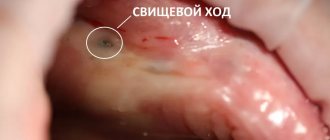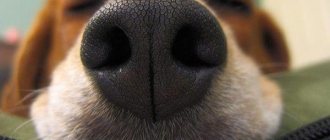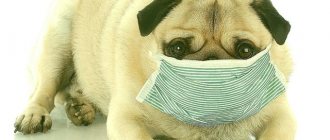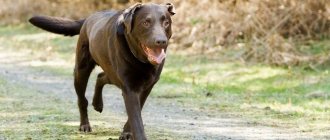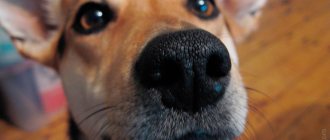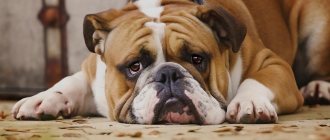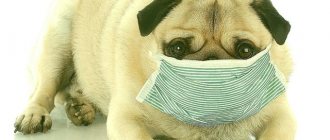The health of the pet is the responsibility of the owner. The dog owner should closely monitor any changes in the health of his pet. It is necessary to monitor the quantity and quality of bowel movements.
The appearance of diarrhea is an alarming signal indicating the development of problems in the functioning of not only the digestive tract, but also the entire body. The appearance of yellow-colored feces in a dog may be evidence of intoxication of the body, problems with metabolism, helminthiases and infectious lesions of the body.
Timely diagnosis in a veterinary clinic will make it possible to prevent the development of dangerous complications and save the animal’s life.
Causes of diarrhea in dogs
Just like in humans, diarrhea in dogs can be a manifestation of a variety of diseases.
Of course, the most common and obvious cause of indigestion is food poisoning or another malfunction of the digestive system. Due to the powerful bactericidal properties of saliva, dogs are less sensitive than other pets (particularly cats) to low-quality or stale food. Moreover, in the wild, the closest relatives of dogs, foxes and jackals (1), are generally able to feed on carrion, but it is worth understanding that most domestic dogs have gone so far from their wild ancestors that they have long ago lost all these talents. Their body has become as sensitive to food as ours. And the first reaction to any problem in the body is diarrhea or, more simply, diarrhea. There are also many breeds that are particularly demanding on the quality and type of food (for example, Chihuahuas), the same applies to white dogs, most of which are allergic.
But it should be understood that malnutrition is far from the only cause of diarrhea, and sometimes we can talk about really serious diseases, such as enteritis, hepatitis, helminthiases, the gastric form of distemper - officially this disease is called carnivore distemper (2) and others. Also, diarrhea in dogs can be a symptom of other ailments that at first glance are not related to nutrition.
“If you notice diarrhea in a dog, we always recommend seeing a veterinarian,” says veterinarian Ruslan Shadrin, “because what manifests itself as a disorder of the gastrointestinal tract does not always relate directly to it, it may be a secondary manifestation of some then another disease. And if it is viral, then it is quite serious, and the owner, unfortunately, will not help here in any way. Also, many diseases not related to digestion can manifest themselves in the form of diarrhea. This is primarily kidney damage. When toxins are not eliminated in sufficient quantities in the usual way, the body gets rid of them where it can: through the skin, through the mucous membranes, resulting in irritation and inflammation. These may also be problems of a cardiac nature: disturbances in blood pressure due to the work of the heart can also manifest themselves as various dyspeptic disorders. Also, the cause may be problems with the central nervous system, since the control of internal organs by the brain is disrupted. We can also talk about problems of organs that are associated with the digestive tract, but function outside it, for example, the liver. As a result, both the endocrine and exocrine systems of the animal’s body suffer.
Therefore, if you notice that your dog has been suffering from an upset stomach for more than a day, be sure to contact your veterinarian.
Bad breath: causes
The most common cause of unpleasant odor is the active activity of pathological bacteria in the oral cavity.
Diseases such as caries, periodontitis, pulpitis, periodontitis, gingivitis, stomatitis, as well as the formation of tartar can lead to persistent bad breath. The second place among the causes of unpleasant odor is dry mouth (the medical term is xerostomia
). Mica, which moisturizes our mouth, has bactericidal properties. It kills bacteria, neutralizes their waste products, rinses and cleanses the oral cavity. If there is not enough saliva produced, bacteria are activated, resulting in an odor. Dry mouth can be a consequence of illness or taking a number of medications. It can also be caused by age: over time, the salivary glands begin to work less intensively, the composition of saliva changes, and its antibacterial properties are lost.
The smell can also be caused by ENT diseases: sore throat, chronic tonsillitis, sinusitis, runny nose.
Another cause of unpleasant odor is diseases of the internal organs. It can be:
- renal failure;
- liver failure;
- gastric diseases (gastritis, stomach ulcer);
- lung diseases.
Smoking is also a cause of persistent bad breath. The smell is caused by substances contained in tobacco smoke and deposited in the oral cavity. The only way to eliminate the unpleasant odor in this case is to quit smoking.
Classification of diarrhea in dogs
Photo: Tima Miroshnichenko, pexels.com
No matter how unappetizing it may sound, but if you notice that your four-legged friend is moving differently than usual, pay attention to the nature of the stool.
If the only deviation from the norm is its consistency - it is more liquid than usual, then the reason for this is most likely a change in diet: either you recently switched the dog to a different type of food, or treated it to something unusual for it. In a word, the food did not go to waste. Draw conclusions and don’t experiment anymore.
However, if the feces have changed not only the consistency, but also the color or they contain mucus, you should be wary. They can be yellow, black, green and completely watery, and sometimes contain an admixture of blood. And here it’s worth contacting a specialist.
It is also necessary to distinguish between temporary diarrhea due to accidentally eaten low-quality food and chronic diarrhea that occurs against the background of more serious diseases.
Bloody diarrhea
If you notice that your four-legged friend is bleeding heavily, this is a reason to sound the alarm. As a rule, such manifestations signal serious disturbances in the functioning of the dog’s body.
The cause may be severe poisoning, and we are no longer talking about stale food - most likely, your dog has swallowed real poison. Also, bloody diarrhea in dogs, and especially in puppies, is a consequence of infection with an enterovirus. And here it is very important to provide timely veterinary care, since, unfortunately, the mortality rate from it is very high.
Enterocolitis (3), caused by foreign bodies entering the dog’s digestive tract, is unfortunately also a common cause of bloody diarrhea. Dogs, like small children, sometimes tend to swallow objects they play with, which in turn injure the delicate intestinal walls, causing bleeding. Sometimes such carelessly eaten little things are eliminated from the body naturally, but sometimes it’s impossible to do without the intervention of a veterinarian.
Bloody diarrhea can also be a manifestation of such a terrible disease as a tumor. In this case, the sooner you contact a veterinarian, the greater the chance of saving your friend's life.
Yellow diarrhea
If your dog's stool is yellow or yellowish in color, this is a sign that something is wrong with his liver. As a rule, this happens due to the fact that the pet is overfed with tasty handouts from the table. Fatty, overly sweet and rich foods can cause disruption of the liver and bile ducts.
If you know that you are weak in following the lead of your dog, who is a master at begging for tidbits, make a strong-willed effort on yourself and stop it. In this case, the yellow diarrhea should go away in a couple of days. But if this does not happen, take the dog to the veterinarian - most likely, we are talking about more serious disorders in the liver.
Green diarrhea
Photo: Tima Miroshnichenko, pexels.com
If you notice this color in the piles left by your dog, then first you need to observe its behavior. There are usually two reasons.
First: the dog started eating grass. There is nothing wrong with this - in the wild, all canines from time to time eat some types of plants to maintain immunity and their own health. At the same time, instinct tells them exactly which types of grass are worth eating.
Second: if you have not noticed any tendency to eat green spaces, you should be wary - in this case, the green color of the feces most likely means congestion in the gallbladder. You are unlikely to cope with this disease on your own, so without delay, take your dog to the veterinarian.
Black diarrhea
This is quite an alarming symptom that you shouldn’t turn a blind eye to. The black color of stool is given by blood that has had time to coagulate, that is, its source is most likely the upper intestines. The cause may be a peptic ulcer or tumor, so it is better to consult a veterinarian as soon as possible.
However, before you sound the alarm about the color of your pet’s feces, first remember what he ate the day before. It often happens that owners are worried about the dog’s red or black feces, but it turns out that the dog just recently managed to pluck raspberry or blackberry bushes in their garden.
Yellow stool
The yellow color of an animal's stool can indicate either a problematic health condition or be the result of consuming foods containing carotene.
Yellow feces are characteristic of such abnormalities as:
- Liver dysfunction (cirrhosis, hepatitis, neoplasia). A yellowish tint to feces appears when the liver malfunctions; it is intermediate and characterizes the transition to lightening of feces to a white color.
- Presence of helminths. The color may be yellowish due to the presence of worms and their larvae in the feces.
- Malfunction of the pancreas. Due to disturbances in the production of hormones, the body cannot cope with the processing of fats and feces acquire an oily sheen and a yellow color.
- Eating foods containing carotene (carrots, cereals, etc.). The animal’s body does not digest carotene and excretes it intact.
Reasons for the formation of yellow loose stools:
- intestinal infections;
- infection with a viral infection, for example salmonellosis, parvovirus;
- incorrect diet.
Treatment of diarrhea in dogs
Photo: Ferrari, globallookpress.com
If you notice that your dog often asks to go to the toilet, then be patient and watch it for 24 hours. Keep your pet on a diet: for the first day it is better to abstain completely from food, but you should give as much boiled water as possible. If the animal’s condition does not worsen - it does not become lethargic, inactive, and the stomach does not hurt when pressed, begin to slowly offer it boiled turkey or strictly skinless chicken breast, liquid low-fat broth, or rice water. In short, care for your tailed friend the same way you would a person who has suffered food poisoning. However, if his condition worsens within a day, it is better to take the dog to a veterinary clinic, where all the necessary tests will be carried out, a correct diagnosis will be made and a treatment strategy will be developed.
The main thing is, do not try to treat your pet with folk remedies, which are most often very questionable and can do more harm than good.
Clinical symptoms
In most cases, cholecystitis is observed as an acute disease. Owners note that the animal has nausea, vomiting, refusal to feed, and pain in the abdominal area. Jaundice is an optional symptom, especially if the common bile duct is open, and may not appear immediately. Its appearance in this case is explained by the development of nonspecific reactive hepatitis and intrahepatic cholestasis in response to endotoxins from the inflamed gallbladder. Cholecystitis, accompanied by stagnation of bile, can lead to acholia and discoloration of stool. The appearance of fever, acute abdomen syndrome and signs of septic shock (shallow breathing, hypothermia, pale gums and a weak but rapid pulse) against the background of these symptoms may indicate a ruptured gallbladder and requires urgent action.
Cholecystitis can be chronic and manifest as periodic nausea in the animal, signs of discomfort after eating, loss of appetite, weight loss, diarrhea, or occur without any symptoms at all (and changes in the gallbladder will be an incidental finding on ultrasonography).
Diagnostics
It should be understood that unless you are a veterinarian yourself, it is better not to take responsibility for making a diagnosis. When your dog's diarrhea does not go away for several days, you should consult a specialist.
“We will definitely conduct a full examination, take the main indicators: temperature, pulse, breathing, etc.,” explains veterinarian Ruslan Shadrin. – Plus, at the same time, we ask the owners about the methods of keeping, feeding and living conditions of the animal, and treating it from parasites. And this helps us make the right diagnosis and prescribe the right treatment. Because self-medication does not always give the desired result. And sometimes we have to treat a dog not for viruses, but for the consequences of such folk therapy, in particular from alcohol poisoning, which owners often give to their pets, trying to cure them of poisoning or distemper.
When going to your appointment, you should bring your pet's feces with you for analysis, which is necessary to identify the cause of the disease. Also, the clinic will certainly perform an ultrasound of the animal’s abdominal cavity, and, if necessary, an X-ray examination, as well as a blood test. If pathologies in the gastrointestinal tract are not identified, veterinarians will examine other organs, since stomach upset can be caused by a variety of reasons.
Other qualities of stool in children
Baby poop can have different textures and other features. Before your baby starts eating solids, his stools are usually soft. Breastfed babies may have loose or stringy stools, while formula-fed babies have harder stools. Mucus in a baby's stool is also common and is rarely a sign of any health problems. If your child shows signs of unusual behavior or illness, you should see a doctor. Dry or hard stool means the baby is not drinking enough fluids or is sick.
Once your baby starts eating solids, hard stool may be a sign of constipation. An infant may become constipated when given foods that the body cannot yet digest.
Very watery stools may be the result of diarrhea. A child with diarrhea has more bowel movements than usual and may have a high fever. Diarrhea can cause dehydration, which is potentially serious in children.
Each child is different, some children have more bowel movements, others less often. Many newborns pass stool after every feeding. A healthy bowel movement frequency for formula-fed babies is once a day.
Modern methods of treatment
Treatment of diarrhea in dogs is carried out after an accurate diagnosis has been made. Also, in addition to the main therapy aimed at eliminating the causes of the disease, a set of measures is carried out to replenish the supply of moisture in the body, which is lost in large quantities during diarrhea. Anti-inflammatory drugs and probiotics are also prescribed, and an individual diet is developed. During the recovery stages, the dog also receives immunostimulants to help its body recover faster.
In severe cases, when the cause of diarrhea is a foreign body in the intestines or a tumor, surgery is prescribed. It is performed under general anesthesia in the presence of an anesthesiologist, so that the health and life of the four-legged patient is not in danger.
Physiological reasons
In the first days after birth, puppies eat only colostrum. In the first month, their diet includes exclusively milk. During this period, yellow stool in a puppy is considered normal. With normal microflora, it takes several hours to digest colostrum. As a rule, the mother licks the puppies, so the owner may not know what color their feces are.
If a puppy is stunted, the dog does not have enough milk, and there are other reasons for introducing complementary foods, the owner may become confused. From birth to 1 month, diarrhea is defined as bowel movements more than 6 times a day.
Yellow feces are considered normal in puppies.
Diarrhea is also diagnosed if the stool becomes too thin or watery. Normally, puppy stool has a yellow tint and a viscous consistency.
Note! Diarrhea in puppies is caused by allergic reactions, overeating or dysbacteriosis. Moreover, the last factor occurs with the introduction of artificial feeding
Preventing diarrhea in dogs at home
Photo: pixabay.com
Since the most common cause of diarrhea in dogs is improper feeding, it is necessary to monitor your pet’s menu. You need to choose the right diet for him and not deviate from it. Under no circumstances should you overfeed your dog - handouts from your table will do nothing but harm. If you are a supporter of natural food, make sure that your tailed friend’s diet is balanced and that the food is fresh and cooked.
From puppyhood, wean your dog from the habit of picking up anything on the street - through such street “delicacies”, infection with parasites or pathogens of various infectious diseases, such as enteritis or distemper, most often occurs.
And, of course, make sure that your dog is less likely to encounter stressful situations - do not shout at him and do not raise your hand under any circumstances, because nervous shocks often affect the state of the body of our smaller brothers.
The most common causes of constipation
To correctly identify the cause of delayed bowel movements, it is necessary to understand how the human intestines function.
Liquids are absorbed by the colon. Stool is formed as a result of food moving down the esophagus.
Stool is stored in the rectum until the urge to go to the toilet occurs. The muscles of these organs serve as an assistant, pushing food.
With insufficient absorption of water and slow work of the muscle layer, stool deforms into a dry and hard state, thereby forming constipation.
There are several main causes of constipation in adults:
- Lack of fiber. With a sufficient amount of fiber in the diet, the risk of bowel disorders is reduced. Fatty, fried foods upset intestinal motility. A soluble type of fiber that helps soften the bowel movement process. Insoluble compounds help all stool pass out. If these beneficial elements are missing, a person suffers from constipation for a long time. It is necessary to quickly get rid of the disease.
- Physical activity. An adult most often develops symptoms of constipation due to an inactive lifestyle. Movement speeds up peristalsis. Their absence slows down the processes of the digestive tract. Metabolism helps to empty the rectum when constipation is severe, so it needs to be stimulated.
- Age. As a person ages, metabolic activity decreases, which leads to slower functioning of the muscle tissue in the esophagus. This reason often causes constipation.
- Diet. Dairy products do not contain fiber, only fatty compounds. Slows down digestion. Eating meat products has a serious impact on the intestines, which are weakened with age. Such food should be washed down with plenty of water, especially for people with a lack of physical activity. Unripe bananas do not contain useful microelements, so they are poorly processed. Bread causes indigestibility of gluten, which is the main sign of stagnation. Sweets also slow down all natural metabolic processes.
- Alcohol consumption. Alcoholic drinks are harmful to the entire body; they dehydrate the body, interfering with metabolism. All these factors make it difficult to go to the toilet normally.
- Calcium and iron supplements. Calcium slows down the digestive system. It takes in too much water, causing the stool to become hard. Iron turns stool black and makes it dry, but does not slow down the process of bowel movement. However, due to such properties, cracks may appear in the anus.
- Pregnancy. About 50% of women suffer from constipation in the first trimester of pregnancy. The hormone progesterone is produced in double quantity, acting as a relaxant for muscle tissue. At later stages, the uterus becomes large and puts pressure on the passages, preventing the free passage of stool. If this is the main reason, you need to get rid of it urgently.
Popular questions and answers
We talked about the treatment of diarrhea in dogs with veterinarian Ruslan Shadrin .
Can diarrhea in dogs be dangerous for humans?
As a rule, the causative agents of canine diseases are not transmitted to humans, however, if we are talking about helminth infections, then a person can become infected with some of their species.
Is it possible to cure diarrhea in dogs at home?
It all depends on the reason. If you know for sure that the dog has eaten stale food or is simply too full, you can give it absorbents and keep it on a strict diet for several days. However, if the reason is not known to you for sure, it is better to consult a specialist.
Why is diarrhea dangerous in dogs?
In addition to the fact that it is often a symptom of serious disorders in the functioning of the animal’s body, diarrhea leads to such unpleasant consequences as dehydration, exhaustion, and lethargy. Not to mention that if the dog lives in an apartment, diarrhea can become a serious problem for the owners, because they will not be able to take their pet outside every half hour.
Why can diarrhea be accompanied by vomiting?
Most often this happens if the cause of diarrhea is food poisoning or foreign bodies entering the digestive tract. The body is simply trying in every possible way to get rid of the foreign object or toxins. As a rule, vomiting occurs first, but when toxins reach the intestines, diarrhea also follows.
Does activated charcoal help with diarrhea in dogs?
Activated carbon acts equally effectively on the body of both humans and animals: 1 tablet per 10 kg of weight. However, it should be understood that charcoal will only be effective if we are dealing with food poisoning. But, if you see that there is no improvement, be sure to contact your veterinarian.
Healthy and Unhealthy Cat Stool: What to Look for
Typically, a healthy cat's poop is fairly pliable (like modeling clay: not too soft, not too hard) and oblong in shape—like a candy bar. This is considered the "gold standard" for excrement. Normal stool is dark brown in color, but not too dark, as dark or even color may indicate the presence of digested blood in the stool. Poop that is too light could indicate a more serious problem, such as liver disease, as it could be a sign of a completely blocked bile duct, says PetWave.
Stool in the form of small, hard balls is considered abnormal and may be a sign of constipation. This is a serious problem for cats because it can indicate health problems such as neurological or metabolic diseases or colon obstruction, notes International Cat Care. According to Wag! Constipation in your cat may also indicate that she is dehydrated. You should definitely contact your veterinarian if your cat is defecating small, hard pellets.
You should also look for unformed, soft or almost liquid stools with mucus without any obvious shape. Diarrhea in cats can be caused by a variety of causes, from bacterial infections to intestinal parasites and food intolerances.
If you do not look closely at the contents of the tray, sometimes you can mistake very liquid stool for urine. So always take a close look at what you're scooping out of the litter in the tray—or you can even use a pair of disposable gloves to check the texture.
Not every unusual cat poop is a cause for panic, but it still requires careful observation. Your cat may have diarrhea for one to two days after a change in diet or a heavy car ride, notes Cornell University's Feline Health Center. However, if such stool lasts more than two days or is accompanied by poor appetite, lethargy, or vomiting, take your pet to a veterinarian immediately, says Dr. Richard Goldstein of Cornell University. It's always better to be safe than sorry.
Symptoms indicating jaundice
Despite the factor that provoked the disease, it is quite easy to detect it by the corresponding shade on the skin, mucous membranes, and sclera. The color varies: from light yellow to rich and bright.
Symptoms will depend on the underlying disease. In your pet's behavior you can notice lethargy, reluctance to move, refusal to eat, and unquenchable thirst. Later, yellowing of the skin and mucous membranes will be noticeable. There may be seizures and paralysis, which are caused by severe intoxication of the body. Your furry friend may look frazzled or exhausted. The body temperature decreases and the urine turns bright orange. The color of the stool becomes pale. There is no stable stool: diarrhea alternates with constipation.
Thus, if you notice that the first signs have appeared, you should immediately go to the veterinary hospital. The disease is dangerous for animals, especially for pregnant animals. In this case, do not hesitate
It is important to go to a good clinic for quality advice and professional treatment.
Treatment for the appearance of orange stool
Treatment for orange-colored stools should begin by contacting a gastroenterologist. He will prescribe several necessary examinations for you, with the help of which the cause of this phenomenon, the specific disease (if it exists), and the stage of its development will be identified. In addition, after the examination you can find out what complications may arise due to the disease. The examination process also includes analysis of feces for the number of red blood cells or white blood cells. If the final results differ from the standard range, then your healthcare professional will prescribe you a comprehensive treatment that can help you avoid stomach or intestinal problems in the future.
If, after the examination, you are diagnosed with an infectious disease, then urgent treatment is required at the clinic. If the disease has already developed strongly in the body, then it is first necessary to carry out restorative treatment, and then begin a course of taking pills, antibiotics, and so on. If it suddenly turns out that the cause of the appearance of orange-colored feces is gallstones, then in this case the intervention of a surgeon cannot be avoided.
stomach-info.ru
Mucus in a child's stool
In a child, mucus in the stool may be the first symptom of rotavirus infection. In this case, the condition is accompanied by fever, severe vomiting, loose stools with an unpleasant odor, drowsiness, irritability and lack of appetite.
Mucus can also be the result of indigestion and may indicate a food allergy. Very often, mucus in the stool appears along with diarrhea or loose, semi-liquid stool. In case of allergies, an elimination diet should be used, excluding foods that can cause allergic reactions in the body. Most often these are dairy products, eggs, cereals and nuts.
In children, mucus in the stool and accompanying diarrhea may be a consequence of long-term antibacterial therapy, which disrupts the balance of microflora in the intestines.
Such illnesses often affect children under two years of age. However, in most cases, symptoms are mild and go away when you stop taking the medicine. In more severe cases, pseudomembranous enteritis may develop. The condition is characterized by diarrhea, watery stools with a very foul odor, and may also contain mucus and blood. Enteritis is also accompanied by abdominal pain, fever and dehydration.
Mucus in a child's stool
